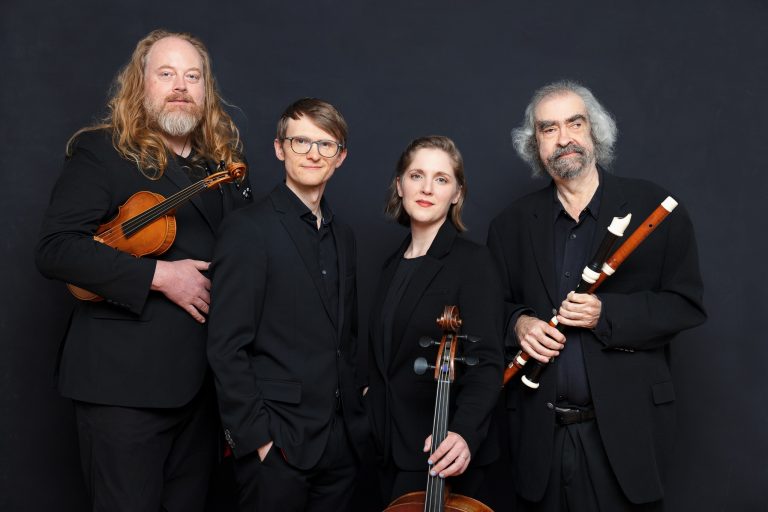By Daniel Hathaway

On Saturday and Sunday at 7 at Blossom, Susie Benchasil Seiter will lead The Cleveland Orchestra in two more performances of “Disney in Concert: the Sound of Magic,” a retrospective of the first hundred years of the Walt Disney Company, including Peter Pan, Moana, Aladdin, The Jungle Book, Frozen, The Lion King, Fantasia, Encanto, & Disney Parks classics.
Local #4 Music Fund presents the Hingetown Jazz Festival on Saturday at 4, featuring Jackie Warren and the Sammy DeLeon Latin Jazz Trio, the Johnny Cochran Trio, the Max Schhlenk Quintet, the Theron Brown Trio, the Tommy Lehman Quartet, the Jamey Haddad Quartet, and the Vanessa Rubin Quartet.
On Sunday at 2:30, the Oberlin Baroque Ensemble, Edwin Huizinga, violin, Michael Lynn, flute, Rebecca Landell Reed, cello & viola da gamba & Mark Edwards, harpsichord, will give a faculty concert in Kulas Recital Hall which you can experience live, or catch on a webcast.
And later that afternoon, The Cleveland Opera & Cleveland Ballet present their annual Opera in the Italian Garden concert in the Italian Cultural Garden on East Boulevard.
Check our Concert Listings for details.
CLASSICAL MUSIC PLAYLIST FOR LABOR DAY:

“Work” has expanded to encompass a wide variety of human activity, as evidenced by a 2014 WQXR poll that asked listeners to nominate classical works that best capture the spirit of Labor Day. Submissions ranged from Handel’s Harmonious Blacksmith to Shostakovich’s Symphony No. 2, from Copland’s Fanfare For the Common Man (countered by Joan Tower’s Fanfare(s) for the Uncommon Woman) to Frederic Rzewski’s The People United Will Never Be Defeated,
One interesting suggestion was Haydn’s “Farewell” Symphony (No. 45), the musical documentation of a labor dispute between Prince Nikolaus Esterházy and his court orchestra that seems ironic during these trying times, when musicians of all kinds have been experiencing furloughs, layoffs, and the disappearance of work.
WEEKEND ALMANAC:
September 2 — By Stephanie Manning

The “dapper and acerbic” Bing never shied away from conflict, even with international opera stars. In 1958, he canceled the contract of soprano Maria Callas over a disagreement, but spent years convincing her to come back. She eventually returned to the Met seven years later in the title role of Tosca, which would mark the end of the 42-year-old soprano’s stage career.
In a review for the performance, New York Times journalist Harold Schonberg described New York City’s excitement over the return of Callas (pictured below):
Hours before the curtain went up, the street outside the opera house looked like one of the circles of Dante’s Inferno. […] The picketers were being jostled by citizens pleading for tickets, at any price. Some bore plaintive signs: ‘A single ticket, please.’
Another person Bing clashed with was Cleveland Orchestra conductor George Szell, who left the Met in 1954 after an argument over his contract. Someone commented afterwards that Szell was his own worst enemy, to which Bing famously replied: “Not while I’m alive.”
Despite Bing’s tenuous relationships with some well-known figures, he was also renowned for integrating the Met’s artist roster and nurturing the careers of singers such as Leontyne Price, who became one of the first African American singers to perform for the company in a leading role. In 1950, while facing some backlash over announcing he would hire singers regardless of race, Bing wrote to a disgruntled subscriber: “I am afraid I cannot agree with you that as a matter of principle, Negro singers should be excluded. This is not what America and her allies have been fighting for.”
September 3
Today, an interesting combination of early and contemporary events to celebrate or mourn, beginning with the installation of Pope Gregory I, aka Gregory the Great, as Bishop of Rome on September 3, 590 (he joined the heavenly multitudes in 604). Gregory is celebrated as the creator of the body of early Christian chant that bears his name, although the story of its origin and evolution is far more complex than the romantic legend that “Gregorian Chant” was dictated to him by the Holy Spirit in the form of a dove perched on his shoulder. Some of the more memorable chant melodies in what might be called “The Pre-Vatican II Great Roman Songbook” — like the Dies irae or the Veni, Creator Spiritus, have been used almost as leitmotivs by later composers. And Ottorino Respighi included a tribute to Gregory as the fourth movement of his 1925 orchestral work, Church Windows (Vetrate di Chiesa) works. Click here for a full performance in 2011 by Vasily Petrenko and the Orchestra dell’Accademia di Santa Cecilia.
Is Mahler dangerous to one’s health? Dutch conductor Eduard van Beinum, born on this date in 1900, suffered a fatal heart attack in Amsterdam in April, 1959 while rehearsing Mahler’s Third Symphony in Amsterdam. In memoriam, click here to watch Claudio Abbado and the Berlin Philharmonic play the Adagio from Mahler 3 in 1998 (and here for the complete symphony).
On this date in 1921, British musicologist, conductor, and keyboardist Thurston Dart was born in London, who later became one of the key figures in the early music movement. Celebrate with a selection of keyboard duets Dart recorded with Igor Kipnis, released in 1972.
And for today’s Something New, on the anniversary of his death in 1974 in San Diego, we recall the experiments that American composer Harry Partch made with many new instruments, including the Chromelodeon, Boo II, and Quadrangularis Reversum. His collection is visitable at the University of Washington in Seattle. Take a tour here with curator Charles Corey, presented on May 30, 2017.
September 4
French composer Darius Milhaud was born on this date in 1892 in Marseilles, though he regarded himself as a native of Aix-en-Provence. After coming to the United States, he taught for some years at Mills College in California, and could be seen during summers at the Central City Opera House in Colorado, where his many operas were regularly performed. On an early visit to the US in 1922, he encountered “authentic” jazz in Harlem, which influenced such compositions as the ballet La création du monde
And on a trip to the United States in 1922, Milhaud heard “authentic” jazz for the first time, on the streets of Harlem,[8] which left a great impact on his musical outlook. The following year, he completed his composition La création du monde. Click here to listen to a 1966 Cleveland Orchestra performance led by Robert Shaw (start at :34 to skip a strange call-in announcement).
On this date in 1965, the Alsatian theologian, missionary, organist and Bach scholar, Albert Schweitzer, died at his hospital in Lambarene, Gabon at the age of 90. Click here to watch an hour-and-20-minute documentary of his life, or here for some charming footage of Schweitzer practicing on his pedal piano that proves that interruptions by pets and wildlife aren’t anything new.
And the celebrated collaborative pianist Irwin Gage was born in Cleveland on this date in 1939. Read his 2018 obituary here and click here to enjoy his recital with Jessye Norman in Florence from May, 1971.



